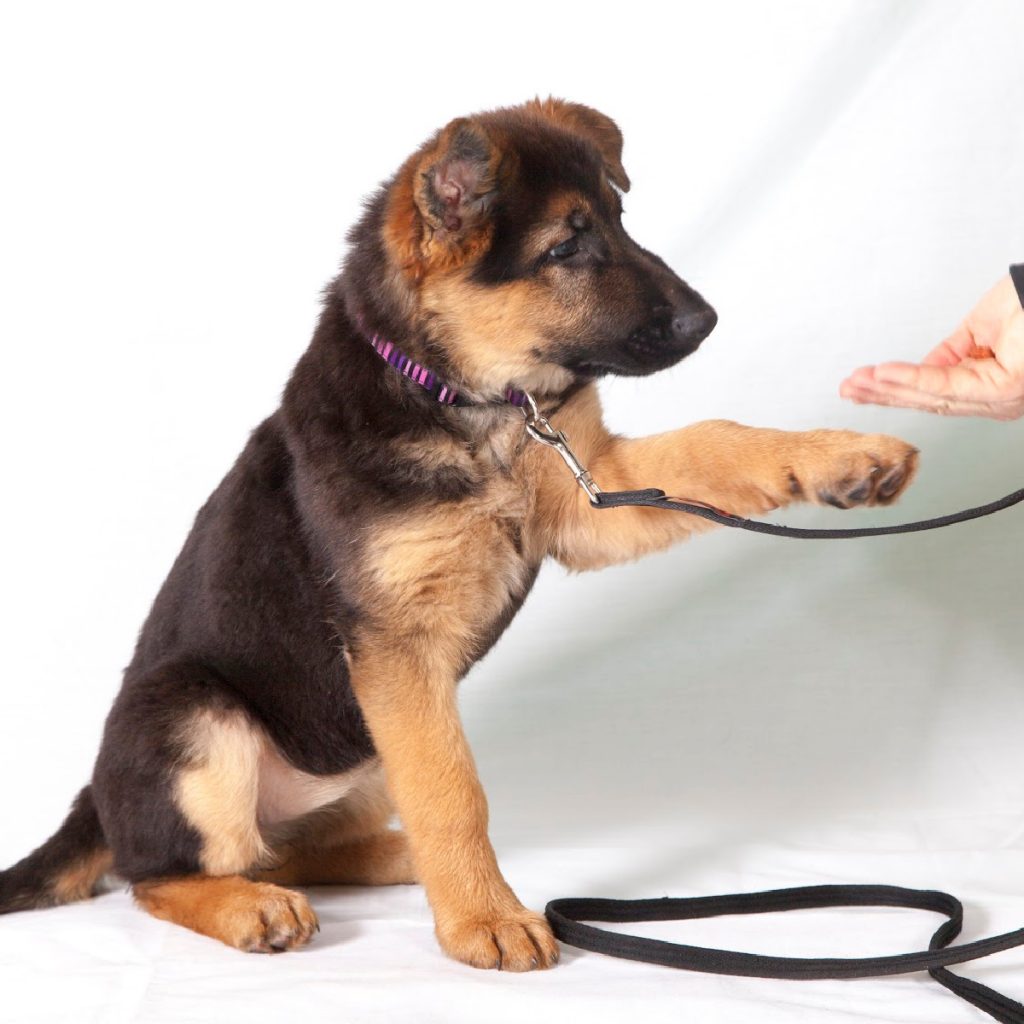From Sitz and Bleib” to Fass and Aus, today we’re diving German dog training commands! We’ll start with a look at the 15 most popular commands, along with their English translations). Then, we’ll go over some tips on teaching your pooch each one! We have much much to discuss (or maybe that should be “viel” to discuss) so let’s dive in!

31 Most Popular German Dog Training Commands
- Sitz (zitz)- Sit
- Platz (plutz)- Down (also used to tell your dog to go to his spot, like his crate)
- Bleib (blyb) – Stay
- Komm (kohm) – Come
- Hier (hee-er)- Here
- Aus (ows) – Drop it
- Gib Laut (gib lauht) – Speak
- Fass (fahs)- Fetch
- Fuß (foos)- Heel
- Steh (shtay) – Stand
- Apport (a-pohrt)- Retrieve
- Pfui (pfoo-ee)- No
- Voraus (foh-rowss)- Go ahead
- Such (sookh)- Search
- Bring (bring)- Bring it
- Brummen (bromen)- Growl
- Halt (hahlt)- Stop
- Warte (vahr-tuh) – Wait
- Bring Holz (bring hohlts)- Fetch Wood
- Ausgang (ous-gahng)- Exit/Leave
- Pass auf (pahs owf)- Watch/Be alert
- Hopp (hawp) – Jump
- Nein (nine) – No
- Rechts (rekts) – Right
- Links (links)- Left
- Voran (foh-ron)- Go ahead
- Ausruhen (ous-roo-en)- Rest
- Rolle (roll-uh)- Roll over
- Platz bleiben (platz blie-ben) – Stay down
- Leck (lek) – Lick
- Ausweichen (ous-vey-ken)- Dodge/Move aside
You can also check out the video below to hear how to pronounce all of these commands:
Why Use German Commands for Dog Training?
German commands are often used in dog sports and competitions. If you’re ever planning on showing or competing with your dog, that alone makes learning them essential. But did you ever wonder why trainers choose German over other languages? If you look at them (or better yet, say them aloud) the answer should come to you. They’re very short, precise, and full of hard consonants- three things that make for highly effective training commands.
What’s so special about short commands and hard consonants?
Simply put, they are easier for dogs to understand and remember. Dogs are particularly good at recognizing and distinguishing sounds, and short commands with hard consonants provide a clear and distinct sound that is easy for dogs to recognize and differentiate from other sounds in their environment.
These commands are also easier for you to deliver quickly and efficiently, which is important when training dogs. Using commands with hard consonants like “sit” and “stay” allows you to quickly and clearly communicate with your dogs, giving them a better chance of understanding you (and, consequently, actually obeying you).
Last, but not least, commands with hard consonants often have a sharper, more assertive sound, which can be helpful in training dogs to respond quickly and attentively. Dogs are more likely to respond to commands that sound confident rather than soft or hesitant commands.
TEACHING YOUR DOG GERMAN COMMANDS (Even If they already know the English versions
If you’ve already trained your pooch to follow all of these commands in English (or any other language, really), you’ll have to do a bit more work. We’ll talk about that in a moment. For now, let’s assume that you’re just starting your puppy training journey.
In that case, teaching your dog to follow German commands isn’t really any different than teaching them to follow the same commands in English. You’ll just swap out the English word for the German version. So, instead of telling Fido to “sit,” you’ll tell him to “sitz.”
Let’s run through the basics for teaching the top 10 commands to your dog. Why only the top 10? Honestly, once you know how to teach your dog to sit, lay down, come, and stay, you pretty much know how to teach them anything and everything else. I’m not even kidding. I taught my dog the “quiet” command in about three minutes using the same exact strategy as I used when I taught her “drop it.”

- Sitz – Sit
To teach your dog to sit on command, start by holding a treat close to her nose and slowly moving your hand upward. Your dog’s head will follow the treat, causing her bottom to lower. Once your dog’s bottom hits the ground, give the “Sitz” command and reward her with the treat.
Repeat this process until your dog learns to associate the “Sitz” command with the act of sitting. Gradually reduce the frequency of treats and increase the time your dog stays in the sit position before being rewarded.
- Platz – Down
To teach your dog to lie down on command, start by having Fido sit in front of you. Then, take a treat and hold it close to your dog’s nose while slowly lowering it to the ground. Your dog’s head will follow the treat, causing it to lie down.
Once your pooch is lying down, give the “Platz” command and reward him with the treat. Repeat this process until your dog learns to associate the “Platz” command with the act of lying down. Again, gradually reduce the frequency of treats and increase the time your dog stays in the down position before being rewarded.
- Bleib – Stay
Start by having your dog sit or lie down. Then, hold your hand up and say “Bleib” while taking a step backward. If your dog stays in place, reward her with a treat and praise.
If your dog moves, gently guide her back into the sit or down position and start again. Repeat this process, gradually increasing the distance between you and your dog, until she can stay in place for a few seconds without moving.
- Hier – Come
Again, start by having Fido sit or lie down. Then, walk a short distance away and call his name followed by the “Hier” command. When he comes to you, reward him with a treat and praise.
Repeat, repeat, repeat, gradually increasing the distance between you and your dog, until he comes when he’s called even from across the yard (a MAJOR feat with my girl since, as a sighthound, she’s always hyperfocused on hunting)
- Aus – Drop it
For this one, we get to start off with a bit of fun! Initiate a game of tug-of-war or fetch with your dog. Give her a few minutes of playtime (it’s not really fair to lure her into a game of fetch only to launch right into a training session, now is it?). Then, when your dog has the toy in her mouth, say “Aus” and offer a treat. When she drops it…you know the drill…give her a treat. Repeat until your dog learns to drop the toy on command without needing a treat every time.
- Gib Laut – Speak
To teach your dog to bark on command, start by getting him really excited or making a noise that usually triggers a bark. When he barks, say “Gib Laut” and reward him with a treat.
Keep doing this every time he barks on command and he’ll get the hang of it pretty quickly. Gradually phase out the initial trigger until your dog can bark on command without any external stimuli.
- Fass – Fetch
Teaching your dog “fass” is as simple as throwing a toy and rewarding her when she brings it back. Start by tossing the toy fairly close by. Like, maybe a foot or so away. Then increase the distance until she’s chasing frisbees like no one’s business AND actually bringing them back to you consistently.
FYI, you’ll use the same basic technique for teaching Fido the Apport (Retrieve) and the Bring command.
- Fuß – Heel
To teach your dog to walk beside you on a leash, start by holding a treat close to your dog’s nose and saying “Fuß” while walking forward. When he walks beside you, give him the treat.
If your dog gets distracted or wanders off, stop walking and bring him back to your side. As usual, repeat until it just “clicks” for him.
- Steh – Stand
For this one, start by having your pooch sit or lie down. Then, hold a treat in front of her nose and slowly raise it above her head. She should stand up to follow the treat. Once she is standing, say “Steh” and give her the treat.
- Such – Search
We’ve mostly covered basics, but this last one is a pretty cool advanced trick that makes for a great “brain game” for your pup. Start by hiding a treat in an easy-to-find location, such as under a chair. Say “Such” and encourage your dog to find the treat. When he finds it, obviously let him eat it.
Repeat this process, gradually hiding treats in more difficult locations, until your dog can search for treats on command. You can repeat the process using his favorite toys and work your way up to other objects.
Training a Dog That Already Knows Commands in English
If your dog already knows the commands in English, it can be a little more challenging to teach them the same commands in German. However, it’s certainly possible with some patience and persistence. Here are some tips to help you teach your dog German commands if they already know the commands in English:
- Start with one command at a time: Choose one command you want to teach your dog in German, and focus on that until your dog has learned it before moving on to another command.
- Use consistent hand signals: Dogs respond well to visual cues, so consider using consistent hand signals along with the German command. For example, you could use the same hand signal you use for “sit” in English when teaching your dog “Sitz” in German.
- Use high-value rewards: When teaching your dog a new command in a new language, it’s important to use high-value rewards like small pieces of cooked chicken or cheese to keep them motivated and engaged.
- Make it fun: Incorporate play into your training sessions by using toys or games to teach your dog the new command. For example, you could use a game of fetch to teach your dog “Apport” in German.
- Be patient: Learning a new command in a new language can be confusing for your dog, so be patient and don’t expect your dog to learn it overnight. Keep training sessions short and fun, and be consistent with your training until your dog has learned the new command.
By using these tips, you can teach your dog German commands even if they already know the commands in English. Remember, consistency, patience, and positive reinforcement are key to successful dog training.
Teaching your dog German commands can be a fun and rewarding experience for both you and your furry friend. By using consistent training techniques and positive reinforcement, you can teach your dog a variety of useful commands that will make it easier to communicate and bond with your pet.

